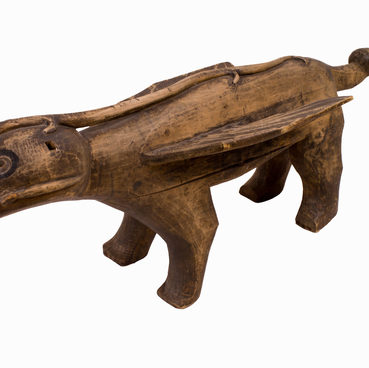The peoples of the Amur region believed that the Dyuli savan was a spirit — the master of the hearth, the patron of the family. The figure of Dyuli was usually leaned against the main pillar of the dwelling. The Nanai people believed that Dyuli’s soul brought happiness to the clan and family.
At the annual autumn family prayer, Dyuli was prayed to for health, prosperity and good luck in hunting. Also, the head of the family always addressed him prior to important events in the life of the family and before the beginning of hunting season. When the master of the house went hunting or left for a long period of time, he would put the Dyuli savan on the bunk, put treats in front of him and made earth-low bows, asking him to bring good luck and success in the planned endeavor, to protect the house and the health of the family.
During the ritual prayer, the savan was served three or four dishes and was censed with wild rosemary. They fed him with meat of sturgeon, kaluga fish and carp, as well as porridge. Then they dressed the savan in leather shoes, as they believed that he walked with his master along all the trails, knew good places for hunting, and helped to drive the beast into loops and traps.
Thankful hunters took great care of the savan, dressed it in a coat of bear fur and treated it to a ritual moshi dish cooked of fish skin. Such figurines were cherished and kept away from prying eyes. Dyuli was an obligatory participant of the rite of consecration of a new house. It was placed on the bunk, near the wall, 10 Chinese smoking candles were lit in front of it, according to the number of pillars of the house. The same number of cups with various treats and three bottles of vodka were also put before it.
The host greased Dyuli’s mouth with porridge, elk fat, and brought treats from each meal. According to some reports, a new sculpture was made for a new house, the old one was not brought into it. And when one of the family members died, the figure of the savan was chopped up and discarded in the taiga.
During the wedding
ritual when the bride was leaving for the groom’s house, the savan was taken
out of the house and tied by the leg to the threshold so that the spirit would
not follow the bride to another clan. The sculpture of the Dyuli savan was made
of larch — the most durable material. This way the savan was kept in the family
for many generations and passed on by inheritance.






